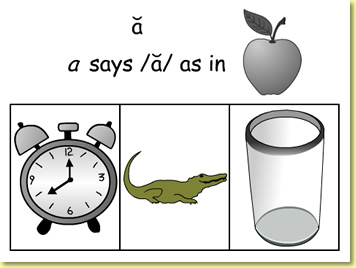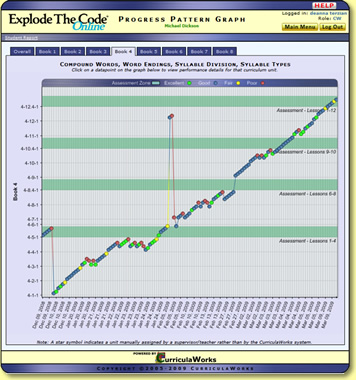STAY INFORMED
Receive ongoing updates about Explode The Code Online.
NEW! FREE Quick Reading Skills Assessment from Explode the Code Online.
This interactive, online assessment will let you know if your students could benefit from phonics instruction.
Get your FREE assessment now!
- What are the system requirements?
- Should my student use the Explode The Code workbooks, Explode The Code Online, or both?
- What do the Explode The Code lessons look like in an online format?
- How do I know where to start a student in the program?
- How does student timing on lessons affect their progress through the program?
- What can I do for students who are placed in the same lesson more than once?
- If my computer is held up/freezes, will data be lost?
- Are there any separate considerations for homeschoolers in using Explode The Code Online?
- Why does my student often repeat lessons that require typing?
- Why don't all the items in an activity set match the skill? For example, in the silent e lessons in Book 3, my child came across an item for which the answer is “cap.”
- Why does it appear that the branching isn’t working correctly in some of the books after February 28, 2009?
Still have a question? E-mail us at support@epslearning.com.
What are the system requirements?
Hardware- Windows: Intel Pentium II 450MHz or faster processor (or equivalent), 256MB of RAM
- Mac: PowerPC G3 500MHz or faster processor, 256MB of RAM
Software
Explode The Code Online supports most modern browsers patched with the latest updates.
The system works optimally with high-speed internet connections. Browsers should be configured to accept cookies and allow Javascript.Should my student use the Explode The Code workbooks, Explode The Code Online, or both?
Each format of Explode The Code has specific benefits, and exploring those will help you decide what is best for your particular student(s). You can also choose to use some of the print products not available online, in conjunction with the online program, to take advantage of their combined features.
Explode The Code’s online format provides a K to 4 phonics curriculum, from Books 1-8, through individualized, data-driven instruction. This saves the teacher valuable time while also supplying ongoing progress monitoring of all students. Students of varying abilities benefit from the online instruction because of features such as: audio and visual cues, immediate feedback, independent learning, and a motivating reward system.
Learn more about Online Features.
A student would benefit from Explode The Code print products if specific instruction is needed in areas such as handwriting, early alphabetic skills, additional comprehension, and focused ELL instruction. Explode The Code print series contains 3 introductory books, 8 books for phonics instruction, “half books” that provide additional reinforcement, 4 comprehension workbooks, a placement test and teachers’ guides.
Learn more about Print Features.
What do the Explode The Code lessons look like in an online format?
Explode The Code Online activities are labeled by Book, Lesson, and Unit. The Book represents the workbook level that covers several phonetic concepts. The Lesson represents the specific concept presented. The Unit represents the type of activity being performed for that concept and is comprised of several activities. Each unit presents one activity at a time and is supported by visual and audio cues for the student to maximize learning.
For example, a lesson would be displayed in the online program as 1-1-1 to stand for Book 1, Lesson 1 (short a with final t), Unit 1 (match picture with same sound for short a with final t) and a single activity within that unit would look like the following:
Click to view larger image.
*Familiar with Explode The Code print workbooks?
See an explanation of the transition from workbook to online format below.
- Matching pictures with the sounds given
- Matching a word with a picture, or with the same word
- Choosing letters to spell a word
- Matching a sentence with a picture
- Answering comprehension questions with yes or no
- Fill in the blank
- Comprehension questions with multiple choice answers
Try a demo of Student Activities.
* The lessons in the Explode The Code print workbooks are broken down into smaller pieces, called units, in the online format. While the workbooks have several pages per lesson, the online program has several “units” per lesson. Also, workbooks present multiple activities on one page, while the online program presents one activity on the computer screen at a time.
How do I know where to start a student in the program?
Although the program is capable of using performance data from assessment lessons to place students, you can save time at the start of the program by placing students according to their general skill level. If you’re not sure where a student should start, you can purchase the Explode The Code Placement Test or utilize the Explode The Code scope and sequence.
Both these tools can help you match your student’s skill level to the skills introduced in a particular book so that you can manually set up a student in an online assessment zone at the appropriate level.
How does student timing on lessons affect their progress through the program?
A student’s speed in the program can only positively impact a student’s progress through the program. If a student successfully completes a lesson without any errors and does so faster than the average student enrolled in the program, that student will receive a butterfly and advance to the next lesson in the lesson queue that has a higher level of difficulty.
In some cases, this may mean that a student will skip a lesson on the same skill with a similar level of difficulty. On the other hand, a student who successfully completes a lesson but does not do so faster than most other students in the program also advances, but will not skip any lessons. Note that students never go back in the program solely because they worked slowly.
What can I do for students who are placed in the same lesson more than once?
Teachers should monitor student progress to check for this occurrence. Students repeat lessons because they did not demonstrate a sufficient degree of progress with the skill as indicated by a score of less than 70% on the lesson.
In some cases, repeating the lesson multiple times can help provide needed reinforcement. In other cases, too much repetition can lead to frustration, especially if the task, not the skill is the challenge.
To determine if the task is the problem, we recommend that you review the type of task and possibly even watch a student working at the computer. If the student appears to have difficulty competing the task, you will want to manually reset the student to a different lesson.
Finally, after several repetitions, the student may need individualized attention or a change of format. Look at “How to Improve This Skill” section of reporting to find further help/tips for instruction in print product.
If my computer is held up/freezes, will data be lost?
No, data is being stored live as the program is being used so you need not worry about lost data if a computer freezes. Buttons earned may not reappear after the computer is active, but data has been stored.
Are there any separate considerations for homeschoolers in using Explode The Code Online?
Explode The Code Online is available to parents and homeschoolers. As a home user, you have the same access to the exceptional, rigorous reporting and individualized instruction as schools and tutoring centers.
If you’re a current home user unsure of how to use the tools and features at your disposal, see the Additional Information for Homeschoolers guide.
Why does my student often repeat lessons that require typing?
Because the hardware found in schools varies enormously, Explode The Code Online needs to account for a wide range of computer speeds. As a result, if students try to type too quickly in lessons that require typing, the letters may not be accepted and the item may be marked wrong.
The best way to avoid this problem is to preview with students some of the lessons (for example, lesson 1-1-3, 2-1-3, 3-1-5, or 4-1-4) that use this format and to instruct them to input answers slowly before they encounter these types of lessons.
Why don't all the items in an activity set match the skill? For example, in the silent e lessons in Book 3, my child came across an item for which the answer is “cap.”
A child's ability to differentiate and review sounds is critical in developing phonics skills. In the case you note, it is important to recognize the sound the vowel makes both in words that do not end in e and words that do end in e.
Thus, in lessons related to this skill, children are presented with a mix of items such as cut, cute, cap, and cape. And because we don’t want a child to assume that the answer will always be a long vowel word if it is found in a long vowel lesson, we vary the correct answer patterns.
Why does it appear that the branching isn’t working correctly in some of the books after February 28, 2009?
In March of 2009, new assessment lessons were added to Explode The Code Online . A couple of assessment lessons were also re-designated as non-assessment lessons. The purpose of these changes was to improve the preciseness of the placement and movement of the student in the curriculum. The graphs in the student summary report reflect the new and re-designated content. As a result, historical data may look strange. New assessment lessons are denoted by an additional decimal in the unit number.
See an example and explanation of this occurrence below.
Click to view larger image.
The graph above shows a student’s progress in Book 4. This student completed several units in Book 4 prior to February 28, 2009. On February 5th, this student successfully completed 4-5-7, the last unit in the assessment lesson covering lessons 1–4.
The student was branched to the first unit in the next assessment lesson, which at the time was 4-12-1. The student failed the unit in this assessment lesson and was placed back to unit 4-7-1 by the Intellitutor.
Since Book 4, lesson 12 was re-designated as a non assessment lesson and two assessment lessons were added, it appears that the student was incorrectly placed ahead more than two assessment lessons after successfully completing 4-5-7. However, the student was placed ahead correctly based on the content that existed before February 28, 2009.


